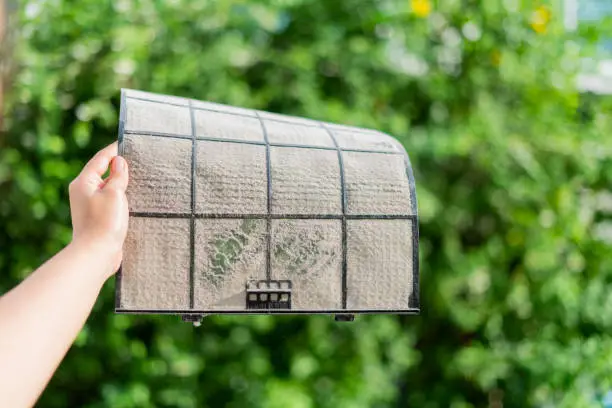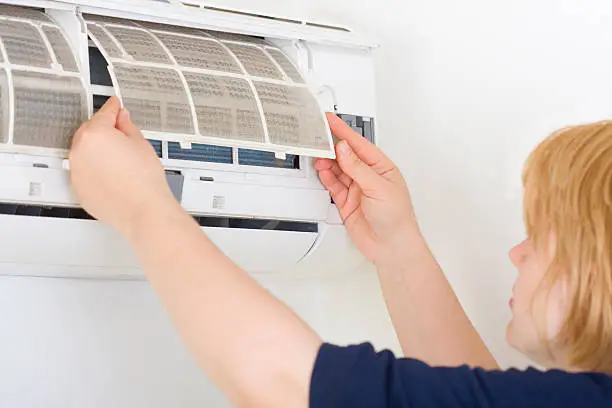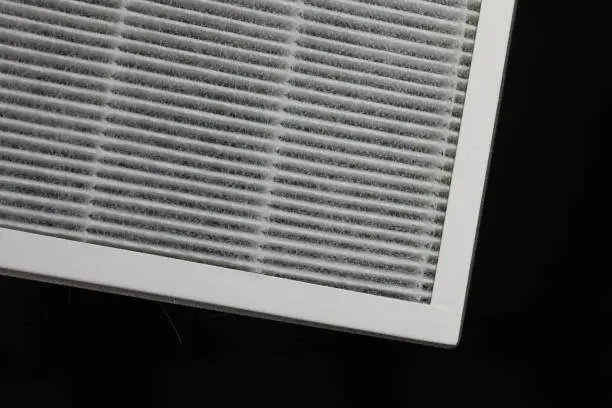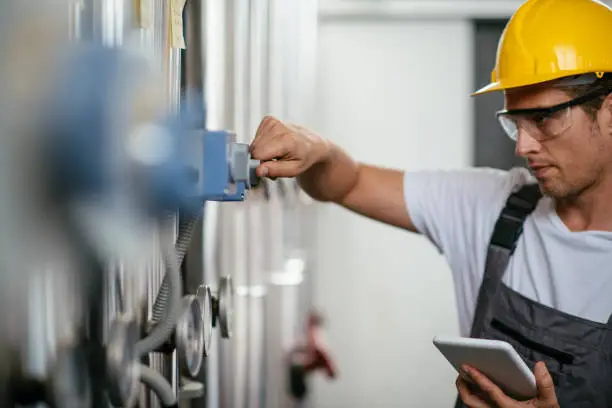
Table of Contents
Maintaining a clean air conditioner filter is not just about equipment upkeep; it’s about ensuring a healthier, more efficient home environment. This guide will walk you through six simple steps to clean your air conditioner filter, a straightforward routine that can significantly enhance your HVAC system’s performance and air quality in your home.
Why Cleaning Your Air Conditioner Filter is Essential
Clean air conditioner filters are the lungs of your HVAC system, ensuring clean air circulation and efficient system operation. Regular cleaning prevents dust, pollen, and other particles from clogging the system, improving indoor air quality and reducing energy costs. Moreover, it extends the lifespan of your air conditioner, preventing costly repairs or replacements. Neglecting this essential maintenance can lead to decreased air flow, higher energy bills, and ultimately, a strained HVAC system.
How to Understand When Your Filter Needs Cleaning?
Understanding when to clean your air conditioner filter is crucial for maintaining the system’s efficiency and the quality of your indoor air. While the cleaning frequency can vary based on several factors, here are more detailed guidelines and signs to help you determine the right time for a cleanup:
- Regular Checks: As a general rule, you should inspect and possibly clean your air conditioner filters monthly, especially during peak usage periods like summer or winter, depending on your location. Homes in areas with high dust levels or pollen may need more frequent checks.
- Visibility of Dirt and Debris: One of the most obvious signs that your filter needs cleaning is the visible accumulation of dirt, dust, and debris. When the filter appears clogged or the dirt layer is noticeable without close inspection, it’s time for a clean.
- Reduced Airflow: If you notice that the airflow from your vents is weaker than usual, it could be due to a dirty filter obstructing the air passage. This reduction can lead to inefficiency in temperature regulation and increased energy consumption.
- Increased Allergy Symptoms or Dust: A dirty filter can exacerbate allergy symptoms and contribute to poorer indoor air quality. If you or your family members notice an uptick in allergy symptoms or if there’s more dust around your home, check the filter.
- Unusual System Noises or Smells: A clogged filter can strain the HVAC system, sometimes causing it to make unusual noises or emit odd smells. These signs can indicate that the airflow is restricted and the system is working harder than it should.
- Energy Bills Spike: An unexpected increase in your energy bills without a corresponding change in usage patterns can be a symptom of a dirty air conditioner filter. When the filter is clogged, your system needs to work harder to circulate air, consuming more energy.
- Seasonal and Environmental Considerations: If you live in an area with high levels of outdoor pollutants, or if it’s the high pollen season, you may need to clean your filters more frequently. Similarly, households with pets, smokers, or a high number of occupants might find that their filters get dirty more quickly.
By monitoring these indicators and understanding the factors that contribute to your filter’s cleanliness, you can better maintain your air conditioner, ensuring it runs efficiently and effectively while providing clean air for your home.
Preparation for Cleaning
Before embarking on the steps to clean your air conditioner filter, proper preparation is key to ensure the process is safe, efficient, and effective. This preparation phase is crucial for both your safety and the maintenance of the air conditioner’s optimal performance.
Gathering Necessary Tools and Materials
The first step is to assemble all the tools and materials you will need for cleaning. This includes a vacuum cleaner with a soft brush attachment to gently remove dust without damaging the filter. If your filter is washable, you’ll need mild soap and lukewarm water for cleaning. It’s advisable to avoid harsh chemicals or abrasive cleaners that could damage the filter or leave residues. Additionally, gather some soft cloths or towels for drying the filter and a large basin if you need to soak it.
Ensuring Safety and Accessibility
Safety should be your primary concern. Make sure to turn off the air conditioner at the thermostat and the circuit breaker to prevent any accidental power-on during cleaning. This eliminates the risk of electrical shock and protects the unit’s components from potential damage. Wearing protective gloves is recommended to avoid direct contact with the dirt and debris accumulated on the filter, which might contain allergens or bacteria. It’s also a good idea to wear a dust mask if you’re sensitive to dust or have respiratory issues.
Preparing the Cleaning Area
Choose a well-ventilated area for cleaning the filter, especially if you’re going to use water and soap. If you’re cleaning the filter indoors, lay down newspapers or a drop cloth to catch any drips or debris. For outdoor cleaning, ensure you have a clean, flat surface to work on.
Understanding Your Filter Type
Knowing whether your filter is disposable or washable is crucial before you start the cleaning process. Disposable filters should not be cleaned but replaced. If you have a washable filter, proceed with the cleaning steps. Always refer to the manufacturer’s guidelines for specific cleaning instructions related to your filter type to avoid unintentional damage.
By thoroughly preparing for the cleaning process, you ensure that you can clean your air conditioner filter effectively and safely, prolonging the life of your filter and maintaining the efficiency of your air conditioning unit.
Check out the pros and cons of washable air filters in our previous article via the link below.
https://thehvacservice.ca/pros-cons-of-washable-furnace-filters/
The 6 Simple Steps to Clean Your Air Conditioner Filter

Now, we move to the core part of our maintenance routine: the actual cleaning of the air conditioner filter. This process is straightforward but crucial for enhancing your HVAC system’s efficiency and ensuring the air in your home is clean. Let’s delve into each step of how to clean AC filter:
Turn Off the Unit
Safety first. Before you touch the air conditioner or its filter, make sure the unit is completely powered off. This means turning off the system at the thermostat and also at the breaker box. This step is crucial to avoid any electrical hazards and to ensure that the system won’t inadvertently turn on during the cleaning process.
Remove the Filter
Carefully access the filter compartment and gently slide the filter out. Hold it by the edges to minimize contact with the dirty surface. For disposable filters, this is the endpoint: simply dispose of it responsibly and replace it with a new one. If your filter is washable, proceed to the next steps. Always check the manufacturer’s instructions to confirm if your filter is indeed washable.
Vacuum Loose Debris
Using a vacuum cleaner with a soft brush attachment, gently clean the filter’s surface. Move the vacuum over the filter in overlapping strokes to ensure all loose particles are captured. Be gentle to avoid damaging the filter’s fibers or mesh. This step helps remove the larger debris and dust before deeper cleaning.
Wash the Filter
Only proceed with this step if your filter is labeled washable. Rinse the filter under lukewarm water to remove any residual dust. Then, apply a gentle, non-abrasive detergent and softly rub it across the filter’s surface to clean it without causing damage. Rinse thoroughly until all soap residues are gone. Be careful not to fold or crease the filter during this process.
Dry the Filter Completely
After washing, the filter must be completely dry before you can reinstall it. Moisture in the filter can lead to mold or mildew growth. Lay the filter on a clean, flat surface in a well-ventilated area or outdoors but not in direct sunlight, which could cause it to warp. Ensure it’s entirely dry, which might take a few hours.
Reinstall the Filter
Once the filter is dry, slide it back into its frame or slot, ensuring it fits exactly as it was before. There should be no gaps around the edges where unfiltered air could pass through. Reinstalling the filter correctly will ensure that your air conditioner continues to operate efficiently and effectively.
While cleaning your air conditioner filter is a manageable task, opting for a professional cleaning service ensures a deeper, more thorough cleaning, particularly for components that are not easily accessible or for filters that require special care.
For a comprehensive cleaning that goes beyond just the filter, consider professional air filter cleaning services by HVAC Service Solutions. Regular professional maintenance can help identify issues before they become major problems, ensuring your system operates at peak efficiency and contributes to a healthier indoor environment.
Reinstall The Filter
Once the filter is dry, slide it back into its frame or slot, ensuring it fits exactly as it was before. There should be no gaps around the edges where unfiltered air could pass through. Reinstalling the filter correctly will ensure that your air conditioner continues to operate efficiently and effectively.
While cleaning your air conditioner filter is a manageable task, opting for a professional cleaning service ensures a deeper, more thorough cleaning, particularly for components that are not easily accessible or for filters that require special care.
For a comprehensive cleaning that goes beyond just the filter, consider professional air filter cleaning services by HVAC Service Solutions. Regular professional maintenance can help identify issues before they become major problems, ensuring your system operates at peak efficiency and contributes to a healthier indoor environment.
So, How Often Should I Clean Air Filters?
So, how often you should be checking those air filters? Well, the thumb rule is pretty straightforward: give them a once-over every 30 to 90 days. But, let’s get real— if your furry friends are shedding all over the place, or you’re sneezing more than usual because of allergies, or maybe your home just tends to attract dust like a magnet, you might want to step it up. In those cases, peeking at your filters every 20 to 45 days could be a game changer. It’s all about keeping that air in your home as fresh as a daisy and your HVAC system humming along without a hitch.
Conclusion and Additional Tips
Cleaning your air conditioner filter is a simple yet crucial task. Regular maintenance not only improves your home’s air quality but also enhances your HVAC system’s efficiency and longevity. Remember, these steps on how to clean AC filters are part of broader system care, so keep surrounding areas clear and check other components periodically.
If you ever feel unsure or encounter a problem while cleaning your air conditioner filters, don’t hesitate to contact professionals. Our HVAC service is here to help with any questions or services you may need to keep your home comfortable and your air clean.
Frequent Asked Questions
How often should I clean my air conditioner filter?
Cleaning your air conditioner filter regularly is crucial for maintaining the efficiency and longevity of your HVAC system. The general recommendation is to clean the filter monthly, especially during periods of high usage. However, this can vary based on factors such as the local environment (e.g., urban areas with more pollutants), the presence of pets, and individual allergies. A clean filter ensures optimal airflow, improves indoor air quality, and can significantly reduce your HVAC system’s energy consumption by up to 15%. Regular cleaning also extends the life of the system, preventing dust and debris from accumulating and causing damage.
Can I just vacuum my air conditioner filter, or does it need a thorough wash?
Vacuuming is an effective way to remove loose debris and dust from your air conditioner filter. It’s a suitable maintenance step for lightly soiled filters and can be done more frequently between thorough washings. However, if the filter is visibly dirty or hasn’t been cleaned in a while, it should be washed with water and a mild detergent to remove embedded dirt and contaminants. Washing is particularly crucial for maintaining filter efficiency and ensuring clean air circulation within your home or business. Remember, some filters are disposable and should not be washed but replaced instead.
What should I use to wash the air conditioner filter?
When washing a reusable air conditioner filter, it’s important to use lukewarm water mixed with a gentle detergent. Harsh chemicals or abrasive cleaning agents should be avoided as they can damage the filter’s material, compromising its effectiveness and potentially leading to breakdowns or reduced efficiency. After applying the cleaning solution, gently rinse the filter under running water to remove any soap residue and dislodged dirt. This method ensures that the filter is thoroughly cleaned without damaging its fibers, which is essential for maintaining optimal air flow and filtration capacity.
How do I know if my air conditioner filter is washable or needs to be replaced?
To determine whether your air conditioner filter is washable or disposable, you should refer to the manufacturer’s instructions or the information provided on the filter itself. Washable filters are typically made of more durable materials with a sturdy frame, often metal or rigid plastic, and are designed to be cleaned and reused. In contrast, disposable filters usually have a cardboard frame and are made of materials that deteriorate when washed. Identifying the type of filter is crucial to ensure proper maintenance and avoid damaging a filter that’s not meant to be washed.
How do I dry the air conditioner filter after washing it?
After washing your air conditioner filter, it’s essential to let it dry completely before reinstalling it to prevent mold and mildew growth. Lay the filter flat or prop it up in a well-ventilated area away from direct sunlight, which can cause it to warp or degrade. Do not use heat sources like hair dryers or heaters to speed up the drying process, as this can damage the filter material. Drying may take a few hours, depending on the humidity and air circulation in the drying area. Once the filter is thoroughly dry and free of moisture, it can be safely reinstalled in the unit.
What are the signs that my air conditioner filter needs cleaning?
Several indicators can signal that your air conditioner filter requires cleaning. Reduced airflow from your AC vents can suggest a clogged filter, as can an unexplained increase in energy bills, which might indicate your system is working harder due to reduced airflow. If you notice more dust than usual accumulating in your home or if the air quality seems to deteriorate, these could also be signs your filter needs attention. Additionally, an increase in noise from your HVAC unit could indicate airflow obstruction due to a dirty filter. Regular inspections can prevent these issues, ensuring your system runs efficiently and maintains good air quality.
Can cleaning the air conditioner filter improve the system's efficiency?
Absolutely, cleaning the air conditioner filter can significantly improve the system’s efficiency. A clean filter allows for optimal airflow, enabling the unit to cool or heat your home more effectively without overexerting itself. This not only conserves energy, which can lead to lower utility bills, but also reduces wear and tear on the system, potentially extending its lifespan. Moreover, an efficient system provides better indoor air quality and maintains consistent temperature control, enhancing comfort and health within your living or workspace.
Is it safe to clean the air conditioner filter myself?
Yes, it is generally safe to clean your air conditioner filter yourself, provided you follow proper safety guidelines. Always turn off the power to your HVAC system before attempting any maintenance tasks to avoid electrical hazards. Use appropriate tools and follow the cleaning instructions specific to your filter type. However, if you’re unsure about the process or if your system requires more comprehensive maintenance, it’s wise to enlist professional services. HVAC Service Solutions offers expert cleaning and maintenance services that can ensure your system is thoroughly and safely maintained.
What tools do I need to clean the air conditioner filter?
The basic tools you need for cleaning an air conditioner filter include a vacuum with a soft brush attachment, mild detergent, water, and a container for washing (if applicable). For washable filters, you’ll also need a clean, dry area to lay the filter flat while it dries. Gloves and a face mask can provide additional protection from dust and debris, especially if you have allergies or respiratory sensitivities. Having these tools on hand simplifies the cleaning process, allowing for regular maintenance that can extend the life and improve the efficiency of your air conditioner.
Why might a professional service be recommended for air conditioner maintenance?
While regular DIY cleaning is beneficial, professional HVAC maintenance services can offer a deeper level of care, particularly for components beyond the filter, such as coils and ductwork. Professionals have the tools, expertise, and experience to thoroughly inspect and clean the system, ensuring all parts are functioning optimally and efficiently. This can help identify potential issues before they become major problems, saving you money and extending the lifespan of your system. HVAC Service Solutions provides comprehensive air conditioner maintenance services, including expert filter cleaning, to ensure your system operates at peak performance.
Share


















